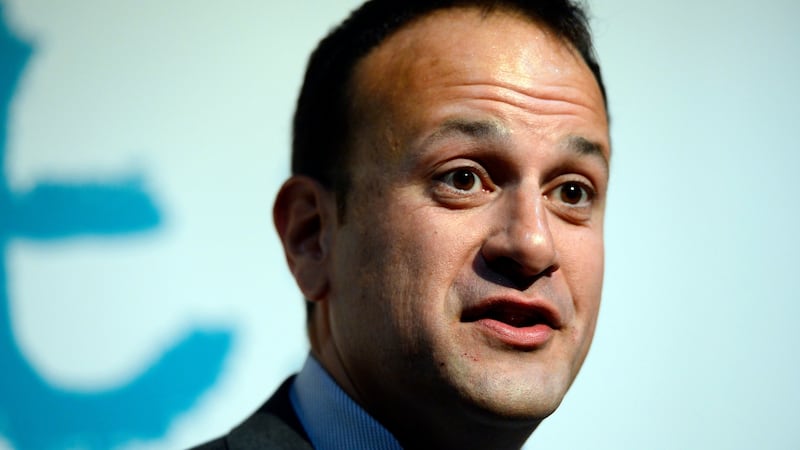In his letter to Fianna Fáil leader Micheál Martin this week, Taoiseach Leo Varadkar gave a clear indication of the shape of next month's Budget. We look below at what it means for the economy, taxpayers and pensioners.
No doubt a few details remain to be fought over, but if we assume his priorities reflect those outlined in the appendix attached to the letter, then the bulk of what is going to happen is now clear.


1. The strategy:
The Government has to decide on the direction of the Budget. It had previously said it would borrow a small amount next year – around €350 million or 0.1 per cent of GDP.
However, many economists have argued that at this stage of the economic cycle, and given the uncertainties ahead, notably from Brexit, it would be better to move the Budget into surplus next year, which means revenue would exceed spending.
In a report on the national debt this week, senior officials in the Department of Finance made this point strongly, as did Central Bank governor Philip Lane in a speech on Wednesday.

However, taking this course would leave less room for manoeuvre on budget day at a time when the clamour for more resources grows ever louder.
The Taoiseach, in his letter to Mr Martin, said the budget would be “broadly balanced” next year, with a plan to move into surplus in 2020.
“Broadly balanced” is the phrase the Government has used to indicate borrowing is within EU guidelines and suggests it will ignore calls to move the budget into surplus next year, in favour of increasing spending a bit more and throwing in some tax cuts.

Depending on how the sums work out, Minister for Finance Paschal Donohoe might just be able to aim for a balanced position next year.
However, disappointing tax returns for August suggest that to do this, and to afford what is promised in the budget, he will have to find new revenue sources.
The other key point is Varadkar wants to continue to commit two euro out of every three available in additional budget resources to spending with the remaining one going to tax reductions, the same formula as included in the current programme for government.
In the event, the balance will be even further in favour of spending in Budget 2019, with €2.6 billion of the €3.4 billion available already committed to higher spending, and the bulk of the €800 million left likely to go in the same direction.
2. Income tax:
Increasing the earnings level at which people enter the higher 40 per cent income tax rate has been the most flagged pre-budget item.

But it now looks like the increase will be more significant than last year, when the top of the standard rate band – the income level at which people enter the higher 40 per cent rate – rose by €750, bringing it to €34,550 for a single person and €43,550 for a married couple with one earner.
( Dual earning couples benefit from a standard band of up to twice the single earner, or €69,100, though there are restrictions).
The Taoiseach said he wants to increase the standard rate cut-off point – the top of the band – to €37,500 for a single person and €46,500 for a married couple with one earner by 2020.
With two budgets to achieve this, going half way in 2019 would mean a €1,500 increase, twice that granted in Budget 2018.

This would be worth €300 next year to taxpayers who earn enough to get the full benefit, which – before any consideration of wage increases – would be anyone earning over the new limit of just over €36,000.
The change would be of no benefit to someone who currently pays all their tax at the lower 20 per cent rate.
There is a caveat here, however. Earnings are increasing, on average by more than 3 per cent this year.
If income tax is not to take a bigger slice of people’s income, then bands and credits would have to increase to match this.
Irish budgets, however, start from the position that any increase in the band is a “giveaway.”
A €1,500 increase in the standard band would be a 4.3 per cent rise for a single employee and thus be a bit ahead of expected wage inflation.
The other clear income tax indication from the Taoiseach was that two specific income tax credits would increase.

There are the earned income credit available to the self-employed and the home carers credit. These would both be increased over two years to match the PAYE credit, currently€1,650.This would be significant extra cash for this who benefit.
The earned income credit is currently €1,150 a year and an equal two-step move would increase it in 2019 by €250 to €1,400.
The home carer’s credit, available to a partner who stays at home to mind a child, old person or incapacitated person is currently €1,200 and again a half way move next year towards €1,650 would increase it by €225 to €1425.
Tax credits are straight cash reductions to your tax bill.
3.Merging USC/PRSI
Interestingly, the Taoiseach again mentioned the idea of merging USC and PRSI into one charge.
The implication is this would be a revamped social charge which in return would see people receive additional benefits.
Civil servants have looked at the options in relation to this, which makes sense in theory though has considerable practical difficulties given the different structure of the two charges.
It is not clear whether any change will feature in Budget 2019, but some further tweaking of USC rates, particularly to benefit lower to middle income earners, can be expected.

4. Raising new revenue
The income tax changes will be expensive – the tax band plan alone would cost around €300 million in each of the next two budgets, for example.
So significant new revenues is needed. The Taoiseach’s letter mentions two options.
One is a direct commitment to increase carbon tax, which is charged on all fuels, with the more polluting ones attracting a heavier levy. The Taoiseach wants to aim to hit an appropriate carbon “price” by 2030 and plans annual increases to get there.

So we will be paying more for petrol, diesel, home heating oil, coal and so on. An increase in fuel allowances are promised to offset the hit to the less well-off. We can also safely pencil in another hike in tobacco tax.
The letter also refers to the local property tax.
This issue is being reviewed by Government officials and may be referred to in the budget. Houses are currently taxed on 2013 valuations.
A revaluation is due in 2019, which would then knock on to new property tax bills in 2020.
Bills will not rise to reflect the rise in house prices in the meantime, as this would lead to a massive hike and huge controversy . . . very unlikely given Varadkar’s stated intention for an election that year.
However, the Taoiseach did not rule out any increases, but rather said that they would have to be “modest and affordable.”
So this could be a source of some extra revenue from 2020 on to help pay for tax cuts in other areas.
The letter makes no mention of one other potential revenue source – the possible increase in the 9 per cent VAT applying to the tourism sector.
Moving this back to the 13 per cent middle VAT rate would yield over €450 million to the exchequer. It is not clear whether a final decision has been made here.
5. Pension and welfare rises
There has been much discussion on whether there should be a generalised increase in pension and welfare payments or more directed increases to help specific groups.
The letter proposes to increase the State pension and weekly social welfare rates “ at or above the rate of inflation.”
Inflation has been low and will probably remain in the 1 to 1.5 per cent range next year. So it looks as if a rise to at least match this for 2019 can be expected.A 2 per cent rise would mean an extra €5 a week for pernsioners, for example.

6. Carry on spending
While as ever there will be much focus on tax, the Government is committing way more of its available budget resources to additional spending, partly due to political pressures in health and housing and partly because, after the cuts during the crash, there are huge pent up demands for cash all over the place.
The Taoiseach’s letter suggests this trend to higher spending will continue. There are at least a dozen spending commitments which will add to what is already planning, ranging from big projects like Sláintecare in health to higher capitation grants for schools, more spending on third level, people with disabilities, arts,culture and sport, community development, the Irish language, community development and so on.
The days of austerity are now well behind us and as well as big increases in capital investment spending by Government, day-to-day spending is also now firmly on the rise, driven by higher pay, more recruitment and pressures in areas like health and education.
For this to continue, tax revenue growth will only have to remain on the rise, driven by an improving economy.
Official forecasts suggest this will happen, with the economy set to continue growing, albeit a bit more slowly.

***********
The bottom line is the “incremental” income tax changes promised by Minister for Finance Paschal Donohoe look set to continue, with the promise of more to come. An average earner can expect cut to their income tax bill of €350 to €400 next year, or around €6.50 to €7.50 a week Pensions and welfare recipients are likely to see a generalised increase too.
Some cash will have to be clawed back, however, and we need to see how this will hit people’s pockets before deciding if we are better off and who are the winners and losers.
Last year the Minister hit the property sector with his main revenue raising measure, a rise in commercial stamp duty, but he may have to look more to the punter this year.
Even a rise in the 9 per cent VAT rate for the tourism sector would likely lead to knock on price increases in bars and restaurants and fuel prices look certain to rise.
If you “ follow the money”, then you can see Budget 2019 is all about spending. However, with improvements in housing, health and transport set to take years to bear fruit, the Government will also try to get some immediate political kudos for its tax package.
Doing this, and keeping the numbers in check, will not be easy. While we know the shape of the budget we can expect some fraught discussions to agree the finer details.
Smart Money is new weekly column that seeks to explain the economic forces shaping many areas of our lives, from property, to education, the labour market and personal finance. If there is an issue you would like to see Cliff Taylor examine as part of this series please email feedback@irishtimes.com.
Next week Smart Money examines why Ireland spends so little on transport compared to other European countries.













